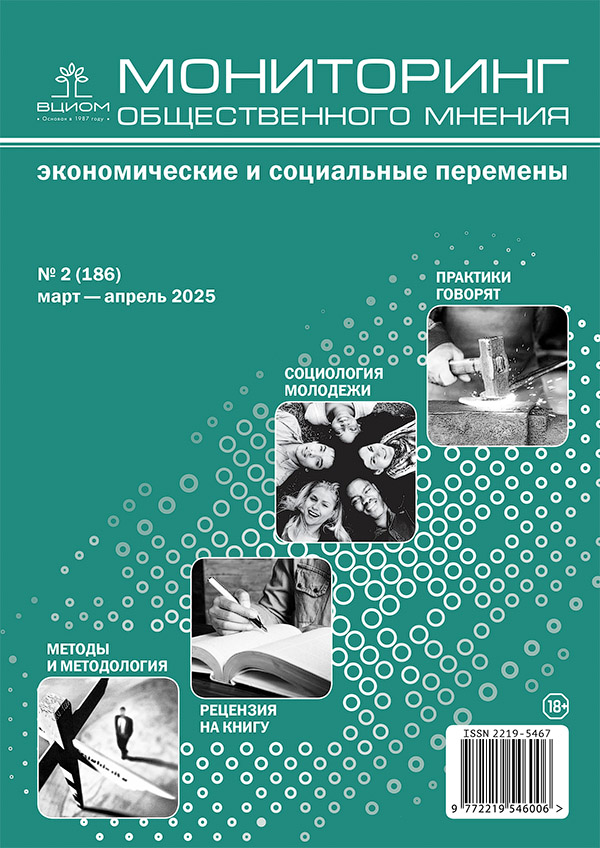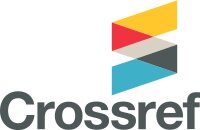Alcohol Consumption Among Russian Youth: How Parental Preferences Determine Children’s Behavior
DOI:
https://doi.org/10.14515/monitoring.2025.2.2772Keywords:
alcohol consumption, types of alcohol consumption, youth alcohol consumption, parental alcohol consumption, RLMS—HSEAbstract
Existing research highlights the role of parents in the alcohol socialization of youth. However, little is known about how parents influence children's preferences in choosing specific types of alcoholic beverages. This study explores the relationship between the alcohol preferences of youth and their parents using data from the Russian Longitudinal Monitoring Survey — Higher School of Economics (RLMS—HSE) from 2012 to 2019. The sample includes 3,095 respondents aged 14 to 22 who consumed alcohol in the 30 days preceding the survey.
The author uses cluster analysis to identify five groups of young people based on the composition of alcoholic beverages consumed, namely: «only beer », «cocktails and other beverages», «wine and beer», «vodka, moonshine, and other beverages», and «cognac, whiskey, liqueur, and other beverages». To assess the relationship between the types of alcohol consumed by youth and their parents’ choices, the author estimates multinomial regression model, with typology of alcohol consumption among youth as the dependent variable and the types of alcoholic beverages consumed by at least one parent as key independent variables. The results show that parental influence extends not only to the fact of alcohol consumption, which has been identified in previous studies, but also to the choice of specific alcoholic beverages. For example, wine consumption by one of the parents increases the likelihood that their adult child will be committed to a type of consumption that includes wine. For instance, parental consumption of wine increases the likelihood that a young person will belong to a group that includes wine. A similar pattern is observed for stronger beverages such as vodka, moonshine, and cognac.
Acknowledgments. The study was supported by the HSE University Fundamental Research Program, project «Russians’ Daily Social Practices under Exogenous Shocks». The author expresses special gratitude to Yana Roshchina and the HSE Laboratory of Economic and Social Research staff for their assistance in working on the article.
References
Горячева Н.В. Модель потребления алкоголя в России // Социологический журнал. 2003. № 4. С. 101—107.
Goryacheva N. V. (2003) Alcohol Consumption Pattern in Russia. Sociological Journal. No. 4. P. 101—107. (In Russ.)
Колосницына М.Г., Золотарёва А. Влияние внешних шоков на нездоровое поведение: пандемия COVID-19 и потребление алкоголя // Мониторинг общественного мнения: экономические и социальные перемены. 2024. № 1. С. 148—175. https://doi.org/10.14515/monitoring.2024.1.2510.
Kolosnitsyna M.G., Zolotareva A. (2024) Impact of External Shocks on Unhealthy Behavior: COVID-19 Pandemic and Alcohol Consumption. Monitoring of Public Opinion: Economic and Social Changes. No. 1. P. 148—175. https://doi.org/10.14515/monitoring.2024.1.2510. (In Russ.)
Кондратенко В.А. Структура и типы потребления алкоголя в России в 1994—2018 гг. // Вестник Российского мониторинга экономического положения и здоровья населения НИУ ВШЭ (RLMS-HSE). 2021. № 11. С. 153—174. https://doi.org/10.19181/rlms-hse.2021.4.
Kondratenko V.A. (2021) The Structure and Types of Alcohol Consumption in Russia in 1994—2018. Bulletin of the Russian Longitudinal Monitoring Survey (RLMS-HSE). No. 11. P. 153—174. https://doi.org/10.19181/rlms-hse.2021.4. (In Russ.)
Кондратенко В.А. Структура и типы потребления алкоголя российской молодежью и их родителями в 2006—2019 гг. // Вестник Российского мониторинга экономического положения и здоровья населения НИУ ВШЭ (RLMS-HSE). 2022. № 12. С. 150—177. https://doi.org/10.19181/rlms-hse.
Kondratenko V.A. (2021) Alcohol Consumption by Russian Youth and Their Parents in 2006—2019. Bulletin of the Russian Longitudinal Monitoring Survey (RLMS-HSE). Vol. 12. P. 150—177. https://doi.org/10.19181/rlms-hse. (In Russ.)
Котельникова З.В. Взаимосвязь практик потребления алкоголя с социальной структурой современной России // Социологические исследования. 2015. № 4. С. 105—112.
Kotelnikova Z.V. (2015) The Relationship Between Alcohol Consumption Practices and The Social Structure of Modern Russia. Sociological Studies. No. 4. P. 105—112. (In Russ.)
Одинокова В.А. Влияние родителей и сверстников на частоту употребления алкоголя подростками // Петербургская социология сегодня. 2018. № 10. C. 169—185. https://doi.org/10.25990/socinstras.pss-10.v6ca-1c18.
Odinokova V.A. (2018). The Influence of Parents and Peers on the Frequency of Alcohol Consumption among Adolescents. St. Petersburg Sociology Today. No. 10. P. 169—185. https://doi.org/10.25990/socinstras.pss-10.v6ca-1c18. (In Russ.)
Пономарева М.С. Оценка микроэкономических факторов потребления алкоголя молодыми людьми. Автореф. дисс. канд. экон. наук. Москва: ВШЭ, 2013.
Ponomareva M.S. (2013). Assessment of Microeconomic Factors of Alcohol Consumption by Young People. Abstract of Dissertation of Candidate of Economic Sciences. Moscow: HSE. (In Russ.)
Радаев В. В. Алкогольные циклы: динамика потребления алкоголя в советской и постсоветской России, 1980—2010-е годы // Мониторинг общественного мнения: экономические и социальные перемены. 2022. № 3. С. 327—351. https://doi.org/10.14515/monitoring.2022.3.2180.
Radaev V. V. (2022) Alcohol Cycles: Trends in the Alcohol Consumption in the Soviet and Post-Soviet Russia, 1980—2010. Monitoring of Public Opinion: Economic and Social Changes. No. 3. P. 327—351. https://doi.org/10.14515/monitoring.2022.3.2180. (In Russ.)
Радаев В.В., Котельникова З.В. Изменение структуры потребления алкоголя в контексте государственной алкогольной политики в России // Экономическая политика. 2016. Т. 11. № 5. С. 92—117.
Radaev V.V., Kotelnikova Z.V. (2016) Changes in Alcohol Consumption and Governmental Alcohol Policy in Russia. Economic Policy. Vol. 11. No. 5. P. 92—117. (In Russ.)
Рощина Я.М., Белова Ю.Ю. Кто перестает пить алкоголь в России? // Экономическая социология. 2024. № 1. С. 11—57. https://doi.org/10.17323/1726-3247-2024-1-11-57.
Roshchina Y.M., Belova Y.Y. (2024) Who Stops Drinking Alcohol in Russia? Journal of Economic Sociology. No. 1. P. 11—57. https://doi.org/10.17323/1726-3247-2024-1-11-57. (In Russ.)
Рощина Я.М., Кондратенко В.А. «Скажи мне, что ты пьешь, и я скажу тебе, кто ты»: как изменялась взаимосвязь между социальным классом и типом потребления алкоголя в России // Мир России: Социология, этнология. 2024. Т. 33. № 1. С. 56—83. https://doi.org/10.17323/1811-038X-2024-33-1-56-83.
Roshchina Y.M., Kondratenko V.A. (2024) 'Tell Me What You Drink, and I Will Tell You Who You Are': How the Interrelation Between Social Class and Type of Alcohol Consumed in Russia has Changed. Universe of Russia. Vol. 33. No. 1. P. 56—83. https://doi.org/10.17323/1811-038X-2024-33-1-56-83. (In Russ.)
Рощина Я.М., Мартыненко П.А. Структура потребления алкоголя как индикатор социальной группы в современных российских городах // Экономическая социология. 2014. Т. 15. № 1. С. 20—42.
Roshchina Y.M., Martynenko P.A. (2014) Structure of Alcohol Consumption as an Indicator of Social Group in Modern Russian Cities. Journal of Economic Sociology. Vol. 15. No. 1. P. 20—42. (In Russ.)
Радаев В.В., Ибрагимова Д.Х., Казун А.Д., Карабчук Т.С., Кондратенко В.А., Котельникова З.В., Косалс Л.Я., Кузина О.Е., Куракин А.А., Моисеева Д.В., Пашков С.Г., Пилипенко Е.С., Поплавская А.А., Рощина Я.М., Стребков Д.О. Как россияне справляются с новым кризисом: Социально-экономические практики населения. М.: Издательский дом ВШЭ, 2023. https://doi.org/10.17323/978-5-7598-2756-6.
Radaev V. V., Ibragimova D. Kh., Kazun A. D., Karabchuk T. S., Kondratenko V. A., Kotelnikova Z. V., Kosals L. Y., Kuzina O. E., Kurakin A. A., Moiseeva D. V., Pashkov S. G., Pilipenko E. S., Poplavskaya A. A., Roshchina Y. M., Strebkov D. O. (2023) How Russians are Coping with the New Crisis: Socio-Economic Practices of the Population. Moscow: HSE Publishing House. https://doi.org/10.17323/978-5-7598-2756-6. (In Russ.)
Allen J. P., Loeb E. L., Kansky J., Davis A. A. (2022) Beyond susceptibility: Openness to Peer Influence is Predicted by Adaptive Social Relationships. International Journal of Behavioral Development. Vol. 46. No. 3. P. 180—189. https://doi.org/10.1177/0165025420922616
Bandura A. (1969) Social-learning Theory of Identificatory Processes. In: D. A. Goslin (ed.) Handbook of Socialization Theory and Research. Boston, MA: Houghton Mifflin Co. P. 213—262.
Bryant L., MacKintosh A.M., Bauld L. (2020) An Exploration of the Impact of Non-Dependent Parental Drinking on Children. Alcohol and Alcoholism. Vol. 55. No. 1. P. 121—127. https://doi.org/10.1093/alcalc/agz086.
Coffelt N.L., Forehand R., Olson A.L., Jones D.J., Gaffney C.A., Zens M.S. (2006) A Longitudinal Examination of the Link Between Parent Alcohol Problems and Youth Drinking: The Moderating Roles of Parent and Child Gender. Addictive Behaviors. Vol. 31. No. 4. P. 593—605. https://doi.org/10.1016/j.addbeh.2005.05.034.
Espinosa-Hernandez G., Noel N.E., Vasilenko S.A., McCrimmon J., Moran A.H. (2022) Associations Between Parental and Adolescent Alcohol Use: The Role of Gender and Familism Support. Journal of Adolescence. Vol. 94. No. 7. P. 1035—1040. https://doi.org/10.1002/jad.12077.
Green G., Macintyre S., West P., Ecob R. Like Parent Like Child? (1991) Associations Between Drinking and Smoking Behaviour of Parents and Their Children. British Journal of Addiction. Vol. 86. No. 6. P. 745—758. https://doi.org/10.1111/j.1360-0443.1991.tb03100.x.
Jackson C., Henriksen L., Dickinson D. (1999) Alcohol-Specific Socialization, Parenting Behaviors and Alcohol Use by Children. Journal of Studies on Alcohol. Vol. 60. No. 3. P. 362—367. https://doi.org/10.15288/jsa.1999.60.362.
Khamis A.A., Salleh S.Z., Ab Karim M.S., Mohd Rom N.A., Janasekaran S., Idris A., Abd Rashid R.B. (2022) Alcohol Consumption Patterns: A Systematic Review of Demographic and Sociocultural Influencing Factors. International Journal of Environmental Research and Public Health. Vol. 19. No. 13. Art. 8103. https://doi.org/10.3390/ijerph19138103.
Lau R.R., Quadrel M.J., Hartman K.A. (1990) Development and Change of Young Adults' Preventive Health Beliefs and Behavior: Influence from Parents and Peers. Journal of Health and Social Behavior. Vol. 31. No. 3. P. 240-259.
Patrick M.E., Schulenberg J.E. (2010) Alcohol Use and Heavy Episodic Drinking Prevalence and Predictors Among National Samples of American Eighth- and Tenth-Grade Students. Journal of Studies on Alcohol and Drugs. Vol. 71. No. 1. P. 41—45. https://doi.org/10.15288/jsad.2010.71.41.
Patrick M.E., Terry-McElrath Y.M., Evans-Polce R.J., Schulenberg J.E. (2020) Negative Alcohol-Related Consequences Experienced by Young Adults in the past 12 Months: Differences by College Attendance, Living Situation, Binge Drinking, and Sex. Addictive Behaviors. Vol. 105. Art. 106320.
Popova S., Rehm J., Patra J., Zatonski W. (2007) Comparing Alcohol Consumption in Central and Eastern Europe to Other European Countries. Alcohol & Alcoholism. Vol. 42. No. 5. P. 465—473. https://doi.org/10.1093/alcalc/agl124.
Power T.G., Stewart C.D., Hughes S.O., Arbona C. (2005) Predicting Patterns of Adolescent Alcohol Use: A Longitudinal Study Journal of Studies on Alcohol. Vol. 66. No. 1. P. 74—81. https://doi.org/10.15288/jsa.2005.66.74.
Poelen E.A., Engels R.C., Scholte R.H., Boomsma D.I., Willemsen G. (2009) Predictors of Problem Drinking in Adolescence and Young Adulthood: A Longitudinal Twin-Family Study. European Child & Adolescent Psychiatry. Vol. 18. No. 6. P. 345—352. https://doi.org/10.1007/s00787-009-0736-x.
Poelen E.A., Scholte R.H., Willemsen G., Boomsma D.I., Engels R.C. (2007) Drinking by Parents, Siblings, and Friends as Predictors of Regular Alcohol Use in Adolescents and Young Adults: A Longitudinal Twin-Family Study. Alcohol and Alcoholism. Vol. 42. No. 4. P. 362—369. https://doi.org/10.1093/alcalc/agm042.
Radaev V., Roshchina Y. (2019) Young Cohorts of Russians Drink Less: Age—Period—Cohort Modelling of Alcohol Use Prevalence 1994—2016. Addiction. Vol. 114. No. 5. P. 823—835. https://doi.org/10.1111/add.14535.
Radaev V., Roshchina Y. (2021) Decline in Alcohol Consumption in Russia: Collectivity or Polarisation? Drug and Alcohol Review. Vol. 40. No. 3. P. 481—488. https://doi.org/10.1111/dar.13253.
Radaev V., Roshchina Y., Salnikova D. (2020) The Decline in Alcohol Consumption in Russia From 2006 to 2017: Do Birth Cohorts Matter? Alcohol and Alcoholism. Vol. 55. No. 3. P. 323—335. https://doi.org/10.1093/alcalc/agaa017.
Randolph K.A., Cheatham L.P., Weiss U.K., Williams J. (2018) Exposure to Parent and Peer Alcohol Use and the Risk of Drinking Onset and Escalation Among Adolescents. Child and Adolescent Social Work Journal. Vol. 35. P. 97—106. https://doi.org/10.1007/s10560-017-0516-2.
Smith M.A. (2021) Social Learning and Addiction. Behavioural Brain Research. Vol. 398. Art. 112954. https://doi.org/10.1016/j.bbr.2020.112954.
Stephenson M., Heron J., Bountress K., Hickman M., Kendler K.S., Edwards A.C. (2023) The Effect of Parental Alcohol Use on Alcohol Use Disorder in Young Adulthood: Exploring the Mediating Roles of Adolescent Alcohol Expectancies and Consumption. Journal of Adolescence. Vol. 95. No. 4. P. 716—728. https://doi.org/10.1002/jad.12148.
Tran T.D., Hammarberg K., Kirkman M., Nguyen H.T. M., Fisher J. (2020) Alcohol Use and Mental Health Status During the First Months of COVID-19 Pandemic in Australia. Journal of Affective Disorders. Vol. 277. P. 810—813. https://doi.org/10.1016/j.jad.2020.09.012.
Van Der Vorst H., Burk W.J., Engels R.C. (2010) The Role of Parental Alcohol-Specific Communication in Early Adolescents’ Alcohol Use. Drug and Alcohol Dependence. Vol. 111. No. 3. P. 183—190. https://doi.org/10.1016/j.drugalcdep.2010.03.023.
Vermeulen-Smit E., Koning I.M., Verdurmen J.E., Van der Vorst H., Engels R.C., Vollebergh W.A. (2012) The Influence of Paternal and Maternal Drinking Patterns Within Two-Partner Families on the Initiation and Development of Adolescent Drinking. Addictive Behaviors. Vol. 37. No. 11. P. 1248—1256. https://doi.org/10.1016/j.addbeh.2012.06.005.
Vashishtha R., Pennay A., Dietze P., Marzan M.B., Room R., Livingston M. (2021) Trends in Adolescent Drinking Across 39 High-Income Countries: Exploring the Timing and Magnitude of Decline European Journal of Public Health. Vol. 31. No. 2. P. 424—431. https://doi.org/10.1093/eurpub/ckaa193.
Wardell J.D., Kempe T., Rapinda K.K., Single A., Bilevicius E., Frohlich J.R., Keough M.T. (2020) Drinking to Cope During COVID-19 Pandemic: The Role of External and Internal Factors in Coping Motive Pathways to Alcohol Use, Solitary Drinking, and Alcohol Problems Alcoholism: Clinical and Experimental Research. Vol. 44. No. 10. P. 2073—2083. https://doi.org/10.1111/acer.14425.
Watts L. L., Hamza E. A., Bedewy D. A., Moustafa A. A. (2024) A Meta-Analysis Study on Peer Influence and Adolescent Substance Use. Current Psychology. Vol. 43. No. 5. P. 3866—3881. https://doi.org/10.1007/s12144-023-04944-z.
Windle M., Spear L. P., Fuligni A. J., Angold A., Brown J. D., Pine D., Smith G.T., Giedd J., Dahl R. E. (2008) Transitions into Underage and Problem Drinking: Developmental Processes and Mechanisms Between 10 and 15 Years of Age. Pediatrics. Vol. 121. Suppl. 4. P. S273—S289. https://doi.org/10.1542/peds.2007-2243C.
Downloads
Published
How to Cite
Issue
Section
License
Copyright (c) 2025 Monitoring of Public Opinion: Economic and Social Changes

This work is licensed under a Creative Commons Attribution-NonCommercial-ShareAlike 4.0 International License.






